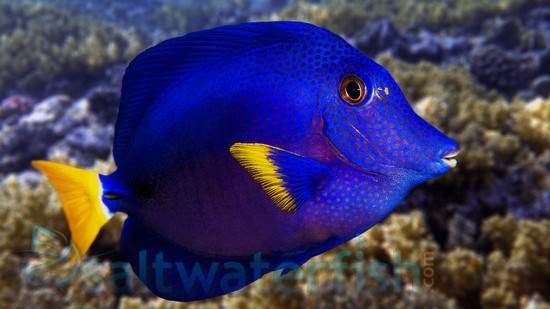The Y-bar Shrimpgoby (Cryptocentrus fasciatus) known to tropical fish keeping enthusiasts as the Y-bar Shrimp Goby, Ninebar Prawn-goby, Bluelined Shrimp goby, Blue Fin Watchman Goby or Barred prawn-goby is widespread in the Indo-West-Pacific from East Africa to Melanesia and the Great Barrier Reef.
Its range extends throughout the East Indian Ocean, West Indian Ocean, Australia, The Red Sea, Indonesia, and Central/West Pacific.
The Y-bar Shrimpgoby is a shy, territorial species that is found in the clear coastal and inner reef sand slopes of their range, often in small colonies at depths from 15 to over 65 feet where they share burrows in the sandy substrate with alpheid shrimps.
Occasionally two Y-bar Shrimpgobies of each color will share a burrow with a single pistol shrimp.
The Y-bar Shrimpgoby has a light gray to blackish, to yellow body color with up to nine wide brown bars along the sides, blue to bluish white streaks on the head that change into blue spots on the body, translucent dorsal fins, pelvic fins with blue spots, and a blue stripe on the anal fin.
There is a barred variety of Cryptocentrus fasciatus with four brown saddles, white or bluish streaks on the head, plain dorsal fins, pelvic fins with blue spots, and a blue stripe on the anal fin.
There is also a dark brown body colored saddled variety marked with whitish saddles on top of the head and along the back; and small white or blue spots or streaks on the head. Males and females are visually identical.
The Y-bar Shrimpgoby is similar to the Yellow Shrimpgoby (Cryptocentrus cinctus) that has a more sharply cornered dorsal fin with bluish streaks.
Both species share burrows with Alpheid shrimp.
The Y-bar Shrimpgoby is best housed in a mature reef or FOWLR aquarium of at least 55 gallon capacity with a thick coralline sand substrate mixed with small shells and small pieces of broken up shells and corals for them to burrow in; some live rock arranged into caves, crevices, and overhangs, and plenty of free swimming space.
When keeping the Y-bar Shrimpgoby with Pistol Shrimp, it is important to provide deep sand of at least three inches and plenty of shells and crushed coral of various sizes so the shrimp has enough building material to dig a stable burrow.
Cryptocentrus fasciatus are frequently housed as mated pairs, and with Pistol Shrimp of the Alpheus genus. Three common types of pistol shrimp pair readily with gobies; the Fine Striped, Tiger, and Candy Cane pistol shrimp.
The Y-bar Shrimpgoby can be kept with other species in large tanks but they enjoy their own territory and can be very aggressive towards approaching tankmates. They are typically peaceful with all other types of fish.
Because this species is known to jump out of open aquariums, a tightly fitting tank lid is recommended.
The Y-bar Shrimpgoby has not been successfully bred in an aquarium environment. Mated pairs will spawn but the fry are difficult to rear into adulthood. Mating takes place in a side corridor off the main burrow. The eggs are guarded in the side burrow by the male until they hatch out, usually at night. The tiny larvae then leave the burrow to become planktonic.
In their natural habitat, the Y-bar Shrimpgoby feeds on benthic organisms in the sea grass, small crustaceans, and planktonic matter that passes by their burrows.
In an aquarium environment they should be fed high-quality meaty items, marine algae, Spirulina, and frozen Mysis shrimp several times a day.
The Y-bar Shrimpgoby (Cryptocentrus fasciatus) is occasionally available to tropical fish keeping enthusiasts as pre-ordered wild caught specimens from online retailers, wholesalers, and transhippers. Prices for small specimens range from $39.99 to $46.50.
Minimum Tank Size: 55 gallons
Aquarium Type: Reef or FOLR
Care Level: Easy
Temperament: Peaceful
Aquarium Hardiness: Hardy
Water Conditions: 71.6 °F – 82.4 °F , dKH 8 – 12°, pH 8.1–8.4, sg 1.020-1.025
Max size: 5.5″
Color Form: Blue, Brown, Black, Yellow
Diet: Carnivore
Compatibility: Reef Safe
Origin: Western Pacific, Indian Ocean
Family: Gobiidae
Lifespan: 5 years
Aquarist Experience Level: Intermediate








